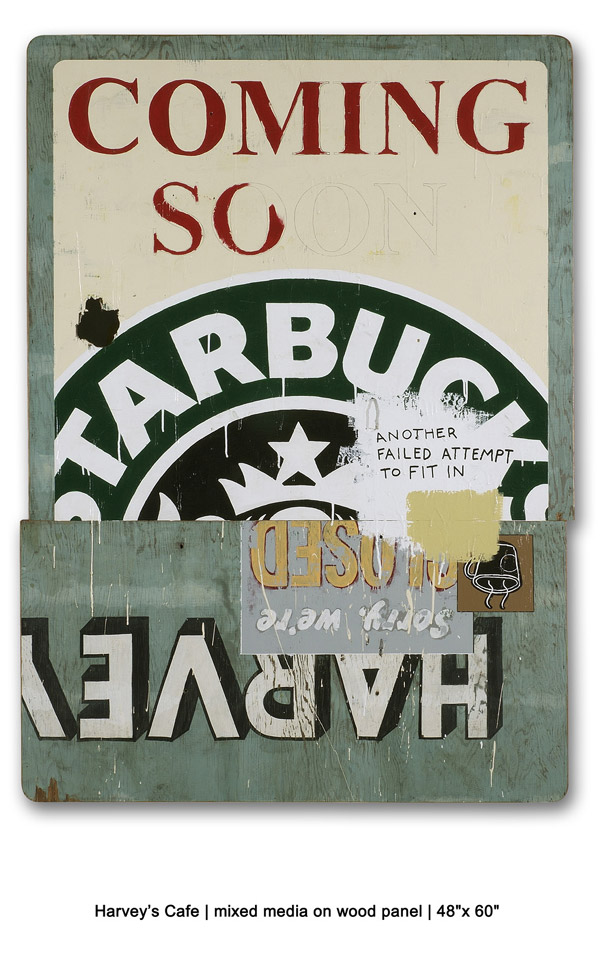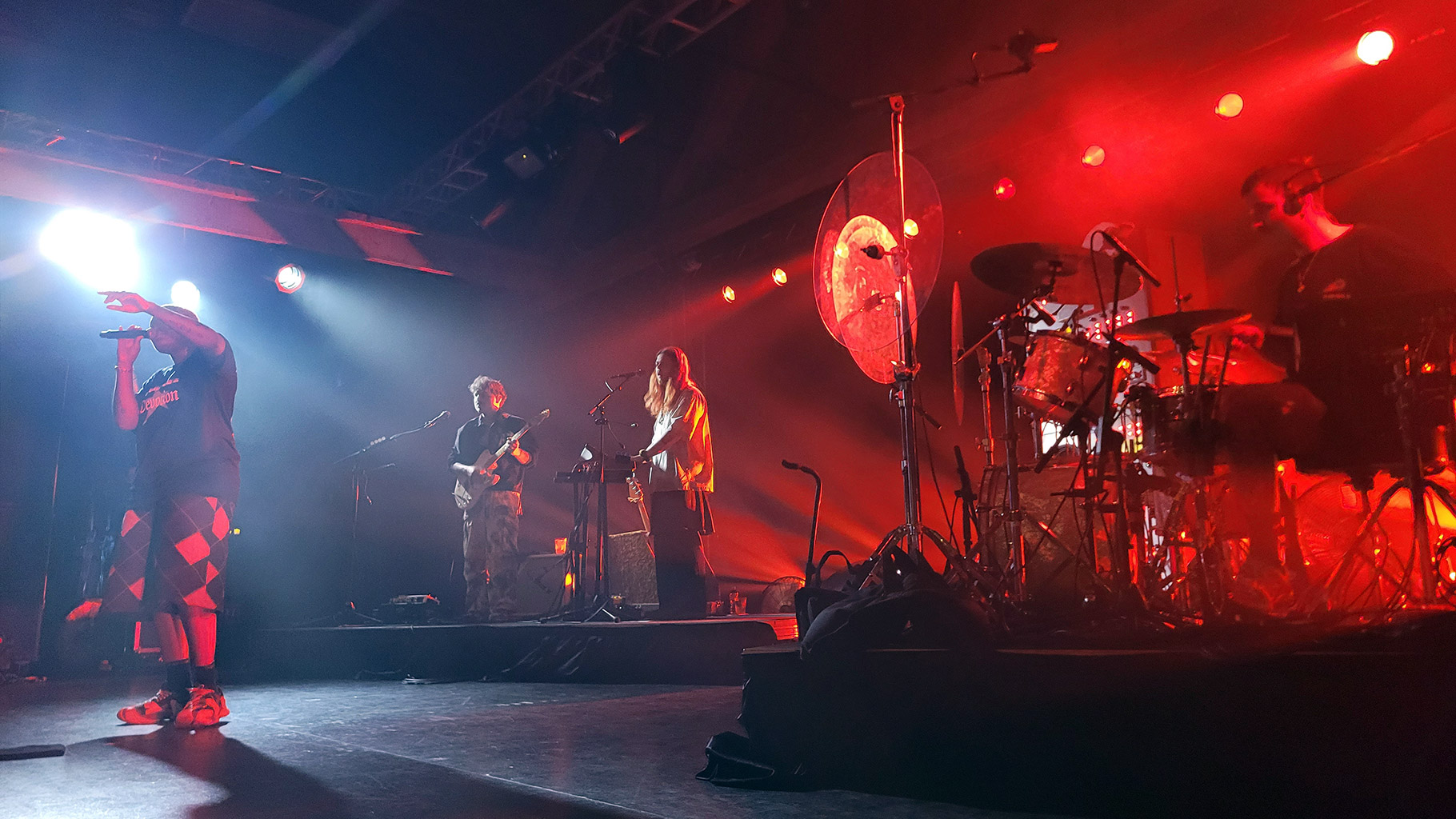
February 2008 Interview
“[I find my materials in] alleyways, roadsides, and other places you’d expect to see junk,” Bask explains. “It’s like being on a treasure hunt sometimes, looking for that perfect panel to paint on.”
When we last spoke to Bask over a year and a half ago, his work was largely motivated by political and social issues. They featured huge amounts of iconic commercial figures and symbols, for example, the Morton’s salt girl or dirty ol’ Linus from The Peanuts.
“When I first started incorporating brand icons into my work, I started to notice how people would react to certain paintings of mine,” Bask recalls. “I started to recognize the power of “the brand,” and their collective messages to consume, consume, consume.”
ARTICLE CONTINUED BELOW


One commercially-inspired piece piece that stood out at that time was one that was created using a sign from an old coffee shop in Miami. The piece was entitled Harvey’s Cafe, and featured half of the green Starbucks crest emerging out of the carcass of Harvey’s Cafe’s old hand-painted sign. Bold red letters above the Starbucks crest read, “COMING SOON,” and a small message is inscribed in ink, saying, “Another failed attempt to fit in.”
At that time, Bask didn’t think much about the closure of the coffee shop and was simply excited to have found an interesting new panel to paint on. But when he returned to Miami months later, he saw that a brand new Starbucks had opened in the location of the old Harvey’s, and it made a significant impact on him.
“We all have heard and seen examples of large corporate chains pushing out the little guy, but this case hit home with me, and I didn’t really know why,” explains Bask. “Maybe it was the change of guard switching out one humble little coffee shop for the bigger, better new one, or maybe it was the fact I actually had a piece of Harvey’s in my studio like an old fossil, [as] proof that it once stood.”
Although Bask does not seem any less politically or socially-aware now than he was before, his works have changed through the years — in context and in influence.
“As an artist, I’m influenced by the current state of affairs as a whole,” Bask says. “There are broad issues like the war in Iraq and our government’s constant missteps, but I’m also influenced greatly by personal issues. Over the years, my work has become less political in theme and more personally intimate in meaning. I’d rather my paintings inspire than preach.”
ARTICLE CONTINUED BELOW

But in some cases, sometimes a message is on the tip of Bask’s tongue, waiting to be heard by the world. We were lucky enough to have Bask custom-design the cover of this issue for us, and as a fan of all types of music, he was clearly inspired by injustices in the music industry when he created this piece. The art features a vintage-style man who looks like a stereotypical corporate fat cat. He is donning a suit and smiling cheekily while a cigar pokes out from through his teeth. On the man’s hand is a scraggly puppet he is controlling; the puppet wears an anarchy t-shirt and is waving flags that say “indi” on them. It’s a clear and forceful message.
“The piece is inspired by the state of affairs in the music industry,” Bask explains. “Words like “indie” and “punk” seem to be fading fast, and in their places, we get deluded [artists] owned by large record labels. I’m not saying [all musicians] on large labels are evil and bad, but in many cases, large labels use smaller, more underground labels in an attempt to legitimize themselves to audiences. They are basically buying street cred.”
As a full-time artist, Bask works at home, in his studio. He may not paint everyday, but art is on his mind daily. Like most artists, if he has a show coming up, he tends to go all out and dives in headfirst. On the topic of crunch time before a gallery showing, Bask says, “I’ll paint 20 hours a day for a week straight, then crash for a few days and repeat the process.”
Bask’s pieces frequently have a decayed look to them, and the amount of detail in every nook and cranny of his work is sometimes hard to keep up with. His pieces look like they’ve been weathered for years, and the paints crack, blister, and peel with personality. These effects, coupled with the use of bright colors and innovative thinking, help Bask’s work command attention in the streets as well as in the galleries.
It is sometimes difficult for artists to find venues that have their best interests in mind, but Bask believes that with enough perseverance and patience, any artist can find those galleries.
And as for the ones that might not look as kindly upon his work as he’d like, he has no qualms about them. To him, it seems simple. Artists need galleries to hang their work in. Sell yourself.
“It must be my graffiti, ego-driven personality,” he says, “but I make my work to be seen by as many people as possible. I chose to be a career artist, and there is no room to be shy.”
But there is a little room to be shy as an artist, particularly when it comes to being present at your own art shows. “[It] is very intimidating,” Bask says. “It’s like standing in a room naked while people come up and praise and/or critique everything about you.”
Bask has not found much difficulty in finding galleries in where to show his street- and graffiti-influenced work. As far as he can tell, street art is becoming more and more mainstream.
“From my experience, street art today is so in vogue that galleries are open to artists that present street elements in their work. Too much so, in my opinion,” Bask admits. “Street art is becoming so mainstream that the figurative pond is becoming muddied up. But like with everything else, time will sift out the true from the rest.”
END.


August 2006 Interview
You use a lot of commercial references in your work. Why? What does this have to do with growing up and noticing the similarities between communistic propaganda vs. commercial icons?
I use commercial images as metaphors or symbols of contradiction in scenarios playing out in my work. The other purpose they serve is as bait to viewers who identify with a particular icon being used. I use the power of familiarity and twist them to deliver a message of my own. As for the communist and commercial comparison? They both use very similar tactics using images to promote a way of life. In capitalism, you have choices, but each individual brand pushes their product the same way a totalitarian regime pushes propaganda.
When did you first find a correlation between communistic propaganda and commercial icons?
When I first started incorporating brand icons into my work, I started to notice how people would react to certain paintings of mine. That’s when I saw a very specific relationship between commercial images and regular folks. I started to recognize the power of “the brand,” and their collective messages to consume, consume, consume. In the Communist regime I grew up in, the message was different, but the way propaganda was relentlessly promoted through the media was very similar.
Do you consider yourself a political person?
I think “conscious” would be more accurate than political. A political person, to me, is someone active in anything from protesting to running for office. Although many of my paintings are political, most of my work deals with more personal and social issues.
What advice can you give artists who are trying to get their work out independently?
I’ve never taken a crash course in art promotions, and have kind of worked on intuition. The secret formula is to be consistently productive in all things involved with your art, and don’t be lazy. The other advice I would give is: make your own opportunities, instead of waiting for them to find you.
What was the first art piece you remember doing that people took notice of?
I think when I used to make little handmade holiday cards for my family as a child. The satisfaction I got after presenting my toiled mess to someone and making them smile was the best feeling ever.
Your works definitely use a lot of textures. Is the love for textures something you’ve always had? Did it emerge naturally from being a street artist first?
Doing street art definitely shaped my approach my art, which would include how textured my work is. Aside from how appealing textured surfaces are to me, what I really enjoy is the challenge of painting on them. It makes it look more like art to me, rather some manufactured promotion.
What is the message behind your street art, and what do you think of random graffiti that does not put forth a message?
The Bask In Your Thoughtcrimes campaign promotes free-thinking and the separation from the status quo. The word “thoughtcrime,” as you may well know, was first coined by George Orwell in the book 1984. I found this word very fitting and appropriate to the message I was trying to put forth. As for other graffiti, I love it. I love all forms of street art, be it a commissioned mural or a tag on a dumpster. The art is the message when it comes to street art and graffiti, and to me, there is no higher art then it.
Can you pick one of your pieces and explain it?
I made [“Harvey’s Cafe”] from a panel I took from a coffee shop that went under in Miami. I don’t live in Miami, so I never had a chance to visit this place. Now, I’ll never get the chance. From what I could gather, though, it was as mom and pop as you can get, and had been there for years before closing. At the time, I didn’t give it any further thought beyond [the fact that] I just found a great panel to paint on. A few months later, I returned to Miami and saw that a brand new Starbucks had opened in the old Harvey’s location. We all have heard and seen examples of large corporate chains pushing out the little guy, but this case hit home with me, and I didn’t really know why. Maybe it was the change of guard switching out one humble little coffee shop for the bigger, better new one, or maybe it was the fact I actually had a piece of Harvey’s in my studio like an old fossil, [as] proof that it once stood.
REDEFINE stands for a lot of the things that your “bask in your thoughtcrimes” mentality does. That being said, it seems similar to your mentality of non-conformity. Want to give our readers a message of sorts in your own vein?
I guess I would quote slogan coined by Joseph Campbell and tell your readers to “follow your bliss.” Non-conformity is a state of mind, so as long as you wake up every morning and love what you do, then, in my opinion, you’re winning the game of life. Not everybody can play a guitar or paint a picture, but everybody has individual hopes and dreams that can be achieved if pursued.
END.








